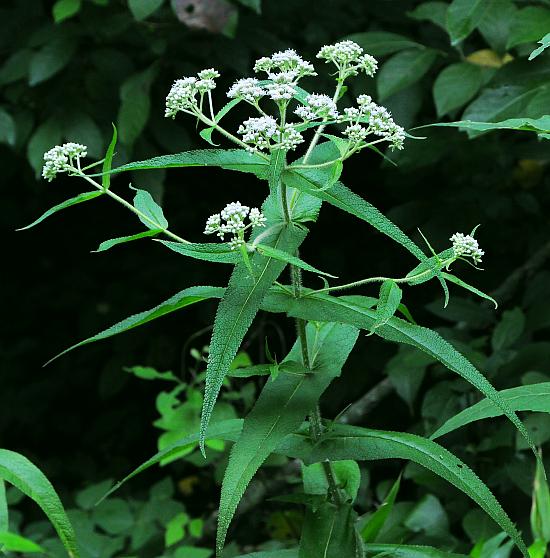Eupatorium perfoliatum L.
Boneset

Native
CC = 3
CW = -3
MOC = 53
© SRTurner
Eupatorium perfoliatum L.Boneset | |
 |
Native CC = 3 CW = -3 MOC = 53 |
© SRTurner |
|
Family - Asteraceae/Eupatorieae Habit - Fibrous-rooted perennial forb, usually with fleshy rhizomes. Stems - Erect, to 1.5 m, not hollow, branching above, densely pubescent with fine, mostly spreading hairs, tan to purple but often appearing gray, not glaucous.
Leaves - Opposite, simple, sessile, mostly perfoliate, decussate, all but the uppermost nodes with the bases of the pair of leaves broadly fused around the stem. Blades 3-20 cm long, 10-450 mm wide, narrowly lanceolate to elongate-triangular, tapered to a sharply pointed tip, the margins bluntly to sharply toothed, the surfaces densely short-hairy, the upper surface usually rugose, the lower surface usually more densely hairy and appearing grayer, roughened or felty to the touch, also sparsely to moderately gland-dotted, with 1 main vein.
Inflorescence - Terminal flat-topped to subdomed panicles of flower heads. Peduncles villous to densely pubescent. Flower heads with +/-15 flowers (florets).
Heads - Discoid. Involucre 4-6 mm long, 3 mm in diameter, cup-shaped, the bracts ovate to oblong-lanceolate or narrowly oblong, rounded to bluntly or sharply pointed at the tip, the margins thin and pale or transparent, especially toward the tip, mostly faintly 3-nerved, densely short-hairy, green but appearing mostly gray.
Flowers - Ray florets absent. Disk florets 9-23 per head. Corollas 2.5-3.5 mm long, the surface often somewhat glandular, white, 5-lobed, the lobes acute. Stamens 5, included. Anthers connate around style, purplish. Style bifurcate, exserted. Pappus of capillary bristles.
Fruits - Achenes 1.5-2.5 mm long, glabrous or minutely hairy along the angles, black at maturity. Flowering - July - October. Habitat - Streambanks, pond margins, bases and ledges of bluffs, fens, sloughs, bottomland prairies, moist depressions of prairies, marshes, bottomland forests, crop field margins, fallow fields, and moist roadsides. Origin - Native to the U.S. Lookalikes - Other species of Eupatorium and Eutrochium, also Brickellia eupatorioides. Other info. - This distinctive species is scattered to common throughout most of Missouri, except for the northwestern quadrant of the state, where it is apparently uncommon or absent. It also occurs throughout the eastern half of the continental U.S. and much of eastern Canada. The plant is recognized by its terminal clusters of small white flowering heads and its perfoliate leaves, which are usually strongly textured on the upper surface. It grows in moist to wet areas but usually not in standing water. Missouri plants have been called var. perfoliatum, with a second variety, var. colpophilium, restricted to coastal saline habitats to the east. The latter variety has narrower leaves and shorter hairs. A hybrid with E. serotinum, called E. xtruncatum Muhl. ex Willd, is believed to occur sporadically. The hybrid has morphology intermediate between the parents. Photographs taken along the shores of the Current River, Shannon County, MO., 8-16-03 (DETenaglia); also at Shaw Nature Reserve, Franklin County, MO, 8-29-2008, Crowley's Ridge Conservation Area, Stoddard County, MO, 10-5-2011, and Busch Greenway / Duckett Creek, St. Charles County, MO, 8-8-2014 (SRTurner). |